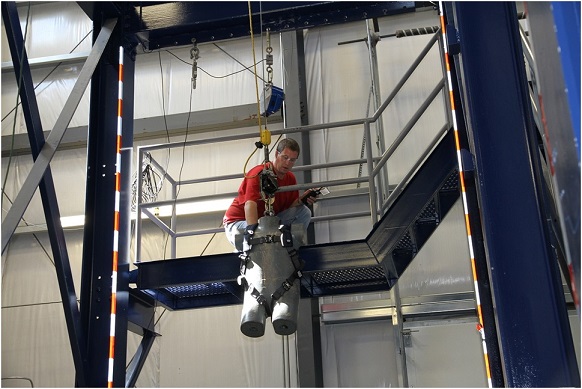
A Capital Safety technician tests a harness with weighted dummy body. The company maintains its own testing lab rather than use an outside facility, in part so that tests are done in a timely manner.
For those who design fall protection equipment, ANSI standards provide guidance for what the equipment should be capable of. That organization has been working on a series of the standards over the years to protect those who work at height. For users, the ANSI Z359 series means tested equipment meets minimal conditions, and possibly more. Recently, the organization issued an umbrella standard, ANSI Z359.7, which says more about the series and testing.
The standard
“The primary standards for the fall-protection industry give direction to manufacturers in terms of how a product must perform and additional details such as labeling and user instructions,” says Capital Safety spokesman Craig Firl. “The standards help make better products and eventually give end users a high level of confidence.”
While specific product standards deal with, for example, details regarding harnesses, self-retracting lifelines, or energy-absorbing lanyards, this latest ANSI Z359.7 standard is a more general standard, or umbrella standard.. “Officially, it’s a qualification and verification-testing standard. It says that for anyone to manufacturer an ANSI Z359 compliant fall protection product, the manufacturer must first meet the requirements of Z359.7. Essentially, it says the manufacturer must test the product in an accredited lab,” says Firl. The standard also describes conditions of the testing lab, such as it must be audited by an independent and qualified third party, and its equipment must be calibrated and met all described requirements.
Firl adds that meeting ANSI Z359.7 means the safety equipment has been properly tested and to the most current version of the applicable component standard. It is unacceptable to pick a previous version and test products to that. A manufacturer has to test and meet every requirement of the ANSI standards. “Other requirements call for retests over periods based on whether or not you have a documented quality system in place,” says Firl.
For manufacturers
The umbrella standard requires that before anything is marked ANSI Z359 compliant, it must be tested in an accredited laboratory. “Our in-house lab meets that requirement and has been accredited by an independent outside agency. That organization came in, audited the lab, examined the records, processes, and procedures. One goal of the standard is that whether a product is tested in a lab in Red Wing, Minn., or California, or in New York, the results are documented and repeatable.”
“Capital Safety has had an in-house ANSI compliant lab for years, but had to make quite a few updates to meet the new ANSI Z359 standard. While it was a big investment both in terms of time and money, the company saw it as necessary investment for its customers,” he says.

The certificate of compliance from Capital Safety, available online from a Certification tab at the company website, tells that the Tie Off Adaptor PT 6’ has been tested to ANSI Z359.1
With a documented quality system in place, Firl says no more than five years can pass before his company must retest a product, as long as the product has not changed Manufacturers may have to test more frequently if they do not have a formal, registered documented quality system in place.
Even though the company has been doing in-house testing, once the standard became active it had to go back and update previous tests. “We performed thousands of tests covering every applicable fall protection product the company offers to comply with ANSI. That is a process ongoing for the last 18 months. So we have made a significant investment, and we are 100% behind the effort and value in ANSI compliance.”
For users
The standard raises the bar for end users and gives them a higher level of confidence that the product they are wearing and using for fall protection has been tested in an accredited lab, and meets applicable ANSI standards. Users will know this because it will carry a label that says so. The appropriate standard is referenced on the label. WPE
A brief look at the ANSI standards
The current ANSI Z359 Fall ProtectionCode, includes the following: .
* Z359.0 Definitions and Nomenclature
* Z359.1 – “Safety Requirements for Personal Fall Arrest Systems, Subsystems and Components”
* Z359.2 – “Minimal Requirements for a Comprehensive Managed Fall Protection Program”
* Z359.3 – “Safety Requirements for Positioning and Travel Restraint Systems”
* Z359.4 – “Safety Requirements for Assisted-Rescue and Self-Rescue Systems, Subsystems and Components”
Updates to the standard in 2009 include:
* Z359.6 – “Specifications and Design Requirements for Active Fall Protection Systems”
* Z359.7 Qualification and Verification Testing of Fall Protection Products
* Z359.12 – “Connecting Components for Personal Fall Arrest Systems”
* Z359.13 – “Personal Energy Absorbers and Energy Absorbing Lanyards”
* Z359.14 – Safety Requirements for Self-Retracting Devices
Source: ANSI
Capital Safety
www.capitalsafety.com
Filed Under: News, Policy, Safety




